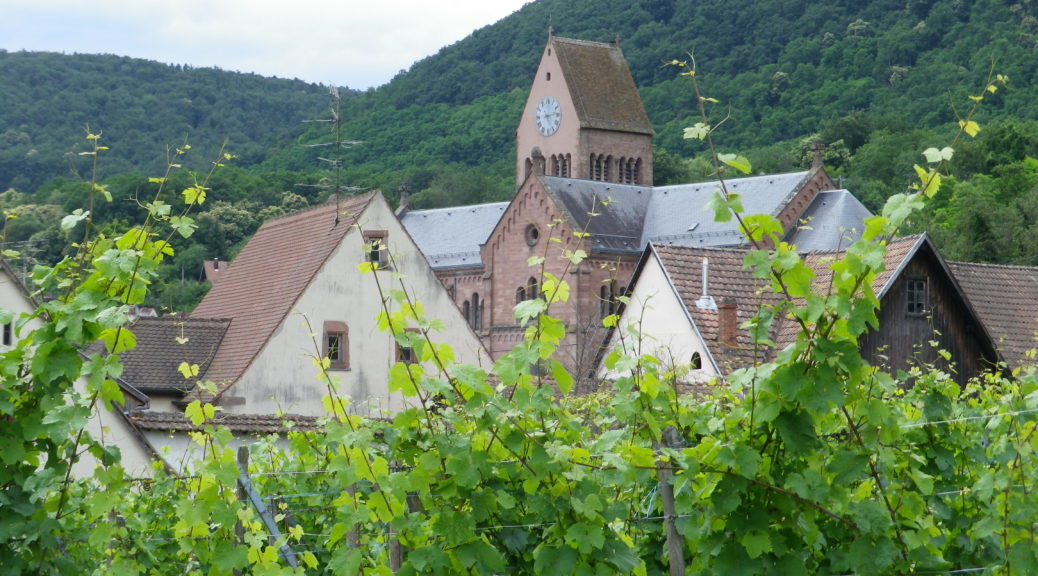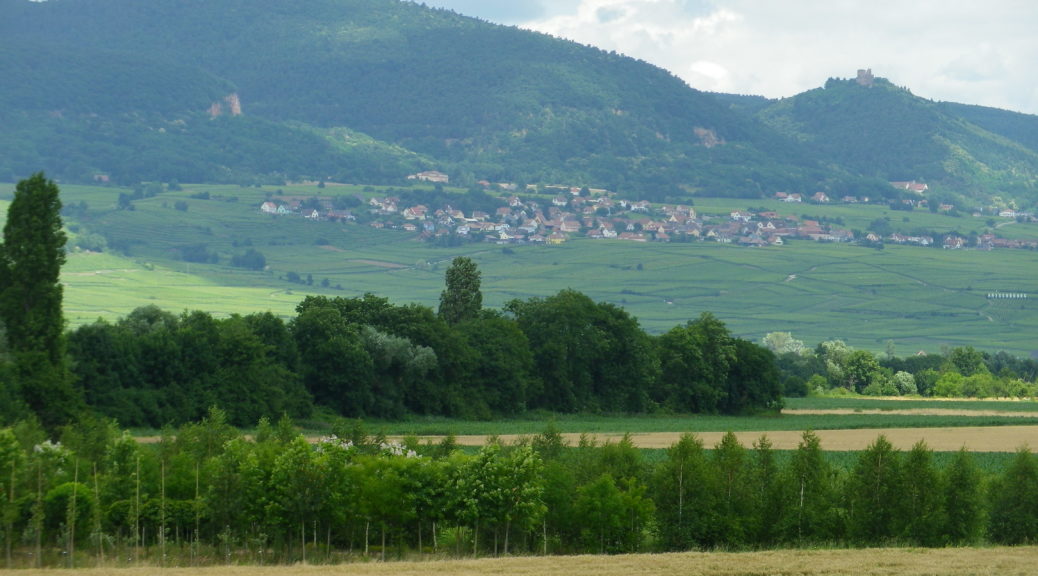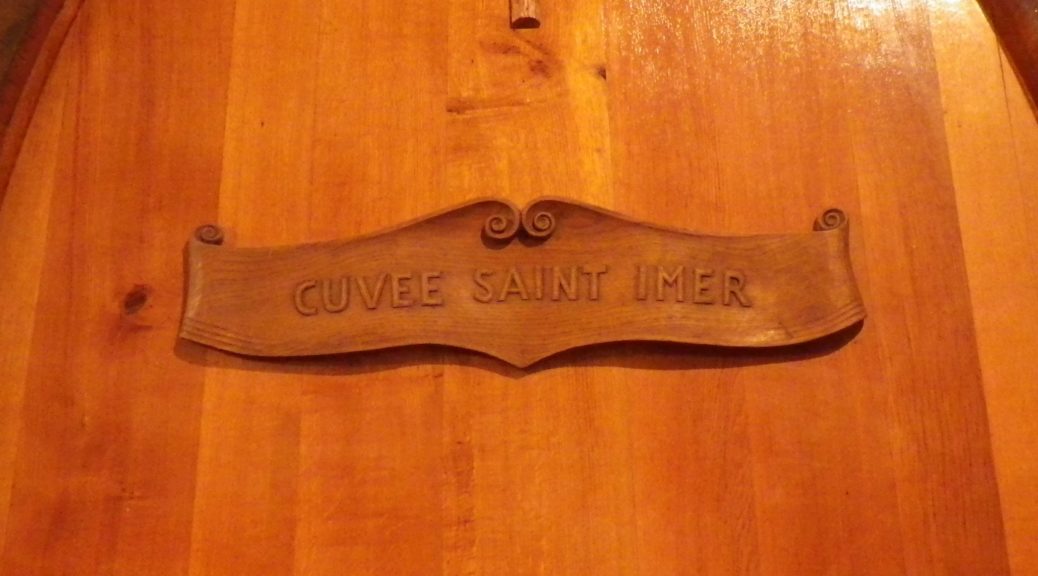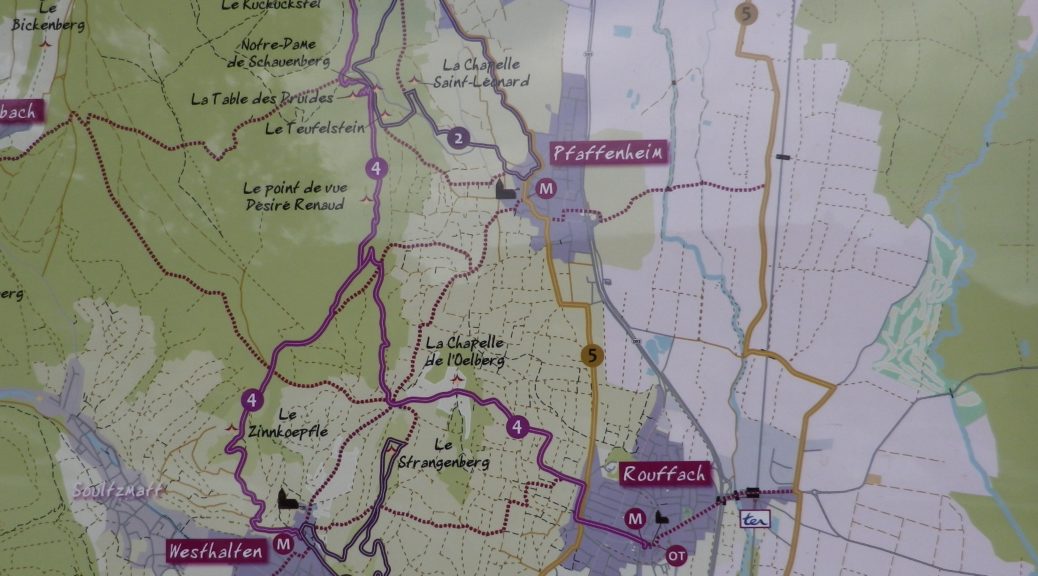Monthly Archives: August 2023
Through Crus and Clos
Passing through vineyards in the Haut- Rhin department in Alsace is always delightful, especially when passing through some Grands Crus vineyards. This trail also ran by, not through, other vineyards known as clos. By definition, clos are vineyards enclosed by walls. They are special places, like the Grands Crus, each with a special pedigree, producing sought-after wines.
This circuit trail began in Rouffach, a town I had never visited. I would visit the compact historical center after my ride, tucked away from the modern main roads (D18Bis), wishing I had more time to spend there! Then again, time there would have meant taking time from some of the other equally delightful towns and villages (Hattstatt, Obermorschwihr, Eguisheim, Voegtlinshoffen, Gueberschwihr and Pfaffenheim) along the route.
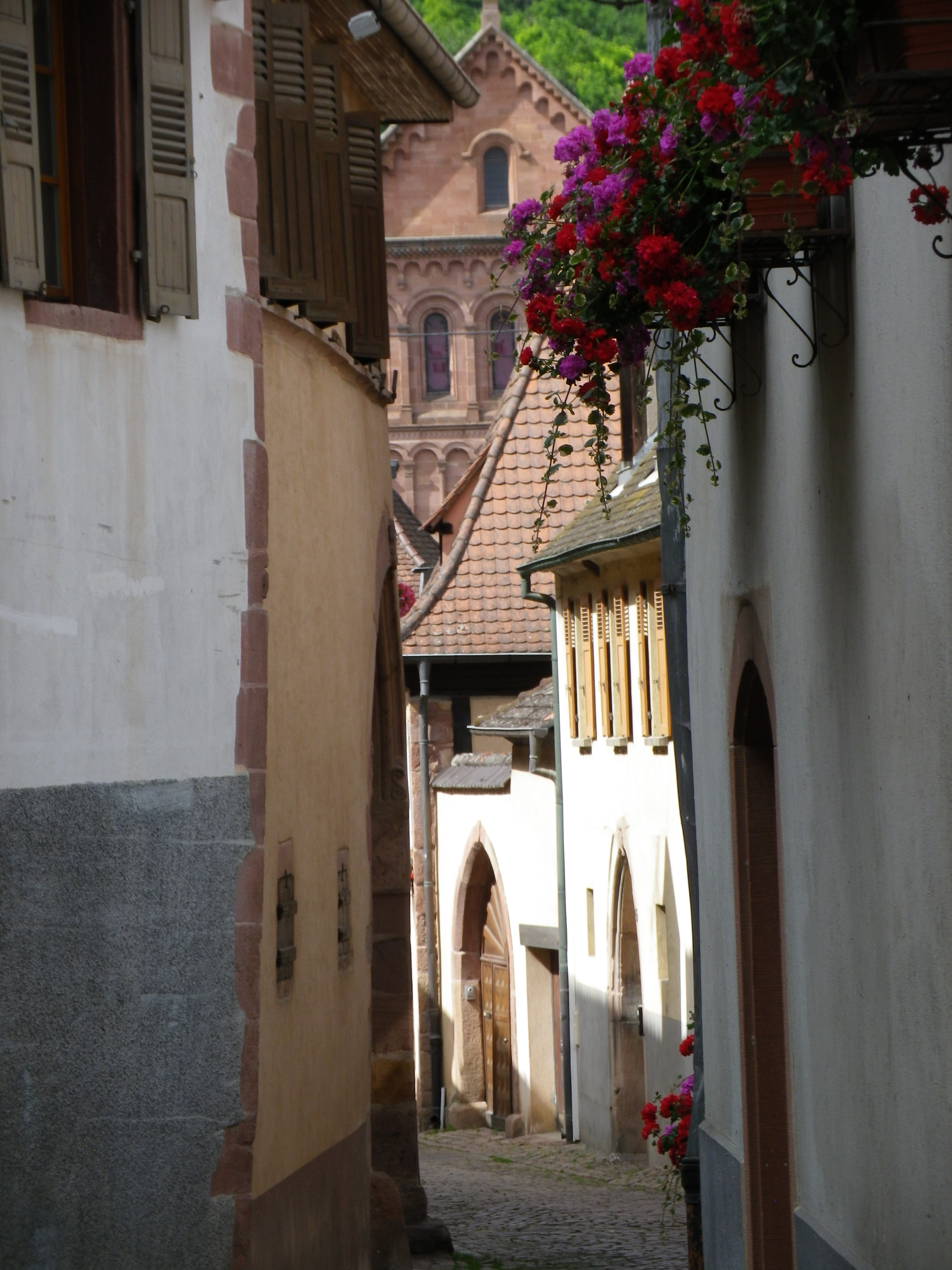
But this circuit was also about the well-respected vineyards in this sector of the Alsace wine region. No sooner through the built-up area of Rouffach, Clos de St Landelin comes into view. Like many clos or Grands Crus, this one also spelled out its name in large letters, another mark of distinction for these special vineyards. Named after an itinerant Irish monk, Clos de St Landelin lies within the Grand Cru of Vorbourg, overlooking Rouffach. I would see this combination of Grand Cru and Clos again, further north, where the Goldert Grand Cru has the Clos de St Imer within it.
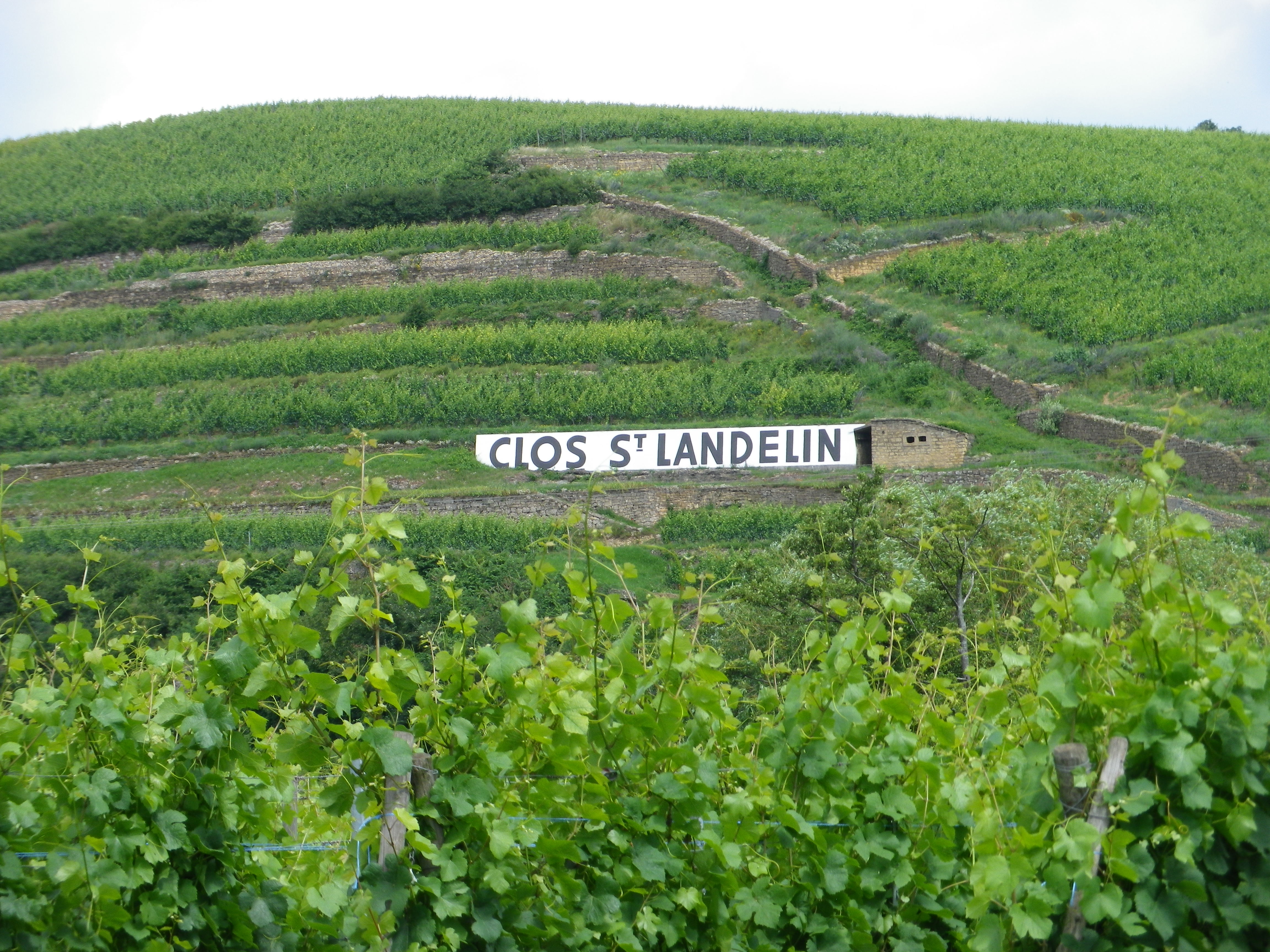
The reason for this is simple. Merovingian kings allotted early monks large territories in pagan areas to encourage conversion, as well as to grow vines (for communion wine). Both vines and conversion went from strength to strength, and soon Alsace was known for both. The circuit took me past both the former Abbey of Marbach, (over 1000 years old), and the nearby Hatschbourg Grand Cru. We have the monks to thank for the rebirth of wine -making in Alsace, and their descendants for doing such a great job of it.
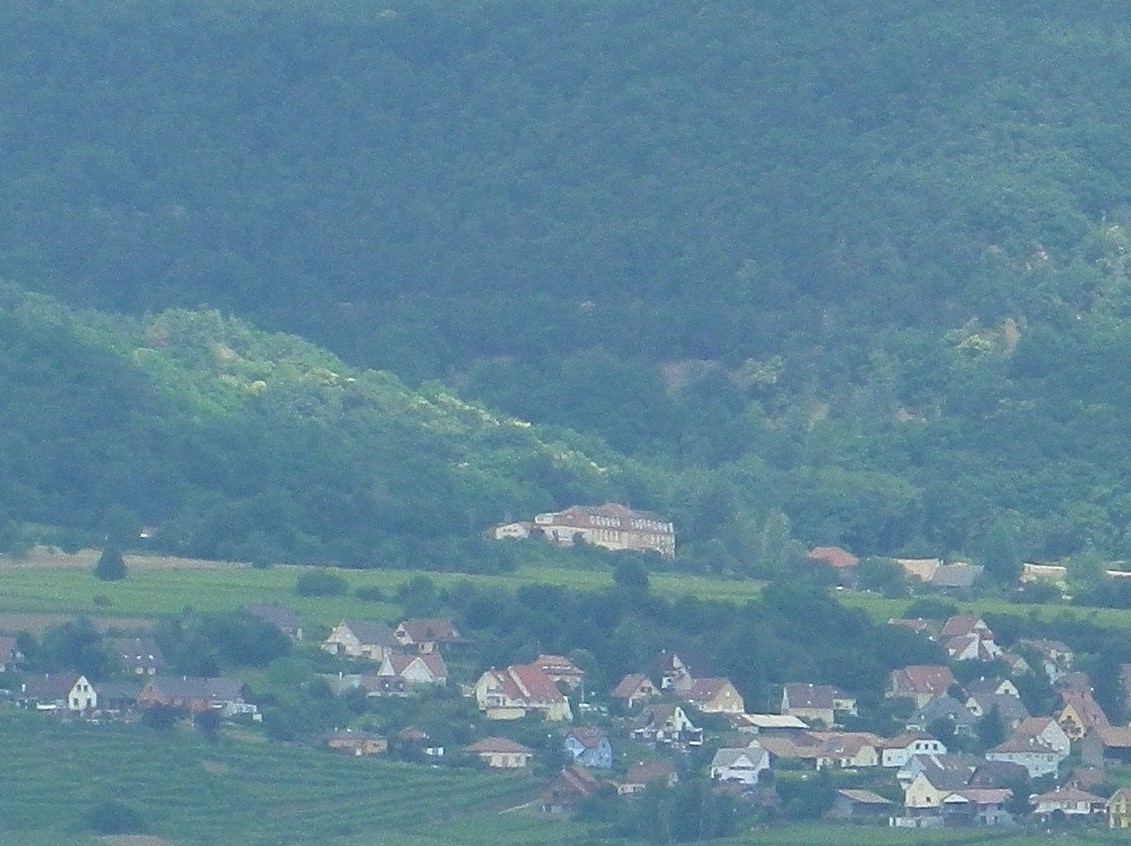
But the height of this match-up came in Eguisheim, at the end of the early Middle Ages. This village which still retains its medieval look, saw a local man, Bruno von Egisheim-Dagsburg, become Pope Leo IX. As son of a nobleman, I wondered, if as a child, he lived in one of the three castles high above the town. (To hike there, see the Nutshell here.) Neither the palace in the center of the village, nor the Chapel of St Leo IX, dates to his era. Nonetheless, the narrow, twisted alleyways, and colorful half-timbered cottages make this a very photogenic village to visit. (Conveniently, Eguisheim marks roughly the half-way point on the circuit, and is the site of a Wolfberger wine cellar – and I love their Cremant!)
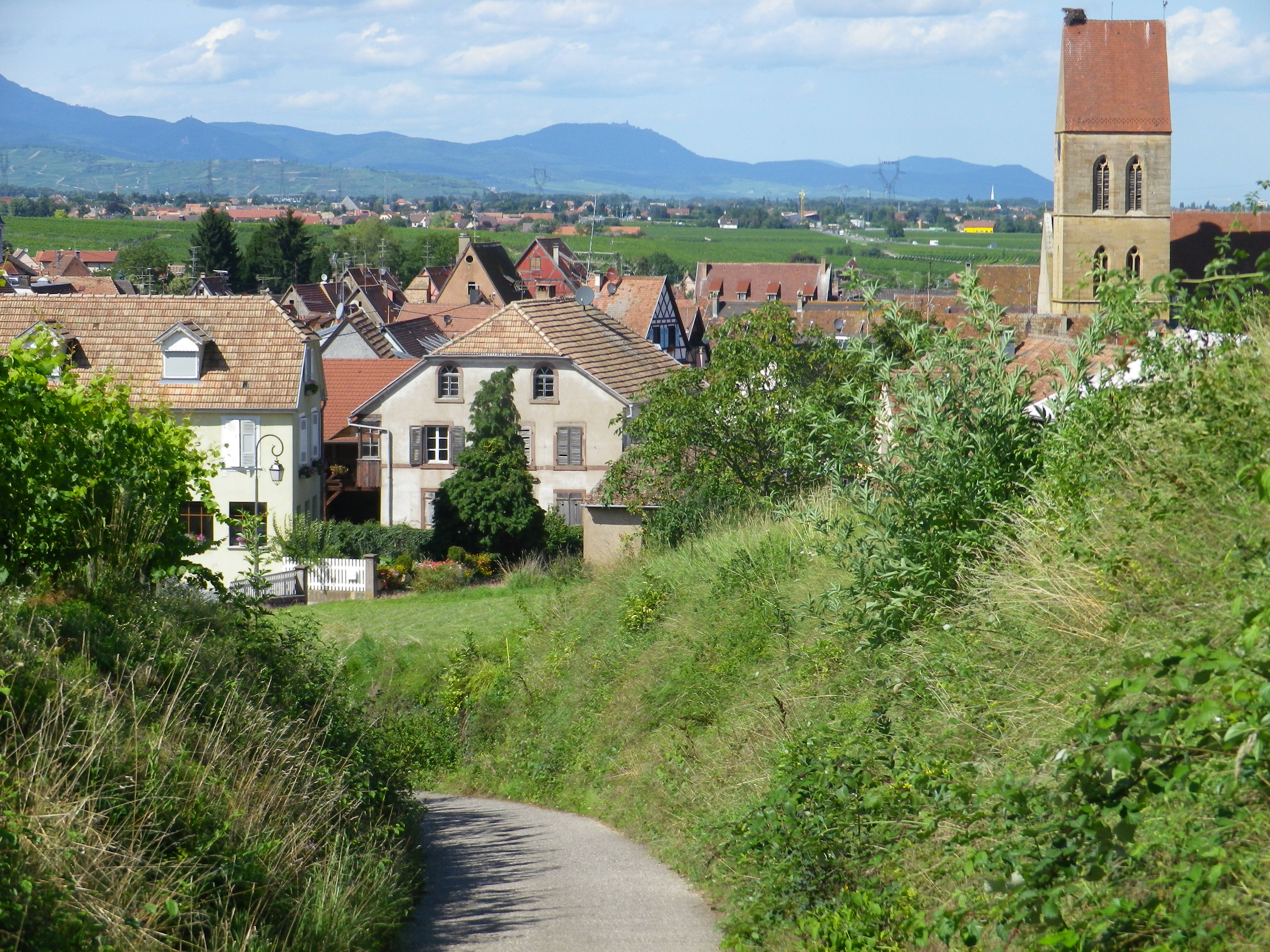
Leaving Eguisheim, up a short but rather steep path (maybe too much Cremant?), I found myself in the middle of the Eichberg Grand Cru. Monks owned this one too, at one point. Shortly after, I was cycling through the Hatschbourg then the Goldert Grands Crus, cruising into Gueberschwihr in no time. This attractive village is home to the Ernest Burn winery. The current owner, whose family’s wine-making tradition dates to 1620, showed me around, and offered more tastes of his Grand Cru Goldert and Clos St Imer wines than I was good for me, at that point. But they were distinctively perfumed and lovely to taste.
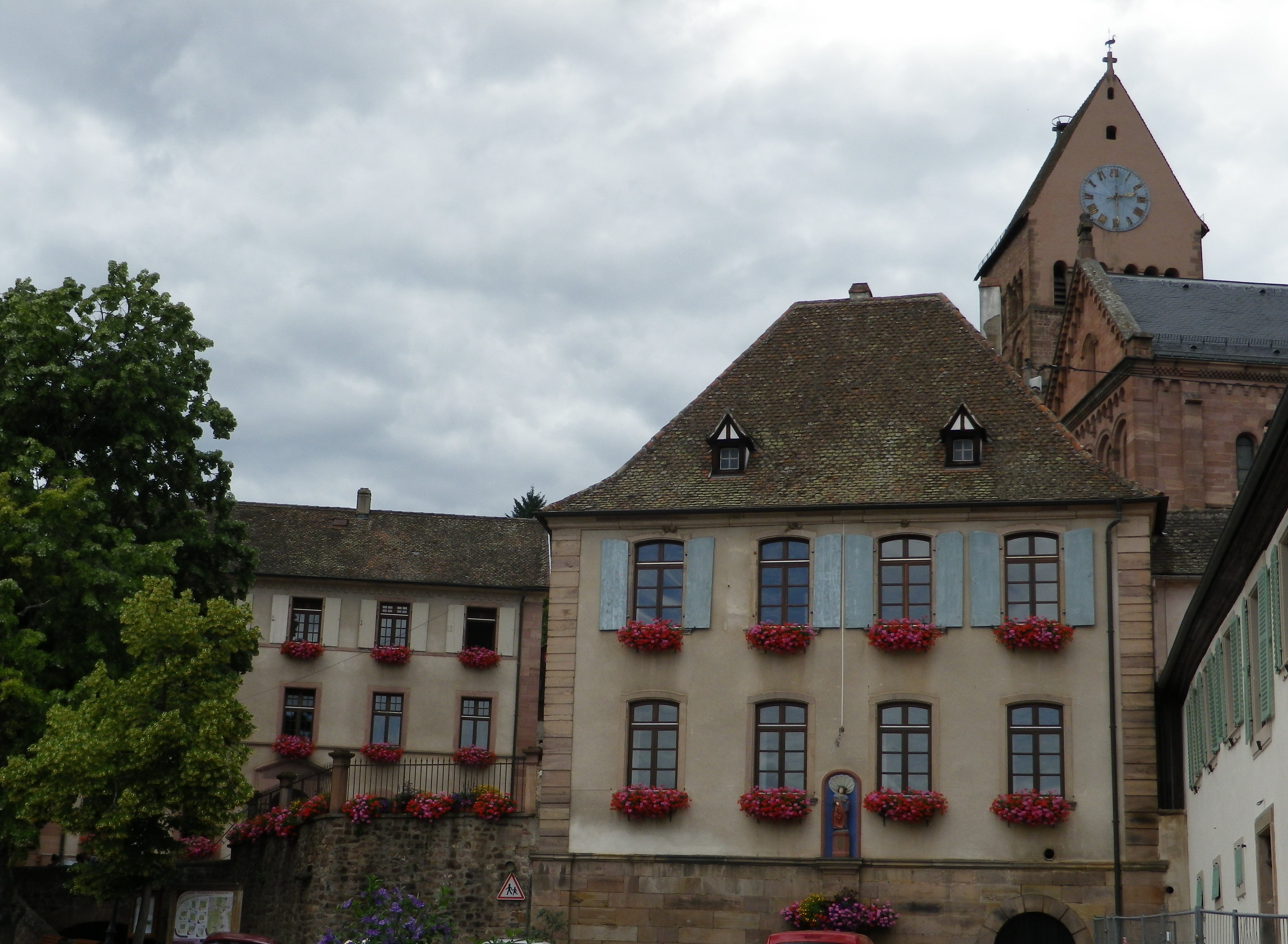
Fortunately, to return to Rouffach, there were only about five kilometers (3.25 miles) to go. With the beautiful weather and views, and having combined the best of both the cultural and viticultural worlds, I found this a really enjoyable, and quite memorable, half-day ride that I was sorry to finish.
Wine Notes: Haut Rhin Grands Crus
What I Learned:
Vorbourg, Hatschbourg, Goldert, Eichberg, Pfersigberg, and Zinnkoepfle are the special vineyard areas in the zone called the Champ de Fractures de Rouffach-Guebwiller, where millions of years ago, the land collapsed. This zone of the Alsace wine region is particularly known for its Grands Crus. The wines from Grands Crus are generally considered superior to non-Grand Cru wines because the terroir where they lie is considered particularly favorable for growing vines. Clos de St Landelin, Clos de St Imer lie within the Grand Cru Vorbourg and Goldert, respectively. The fact that these sub-sections of vineyards were enclosed indicates that grapes matured here especially well, and were tempting targets for thieves! Due to the particular nature of conditions here, certain grape varieties do very well in this zone. About 50 percent of the wines from these vineyards are Gewuerztraminer, followed by Riesling and Pinot Gris.
The Clos de St Landelin is a monopole (owned by one owner, in this case the Mure family), and sadly, I didn’t taste any of their wines. But I did taste a range of Ernest Burn winery’s Clos St Imer/Grand Cru Goldert wines. Burn offers wines with low acidity. They achieve this by delaying picking as long as possible (without becoming a vendage tardive, or late harvest, wine), then keeping one year in stainless steel tanks, followed by two years in wood barrels (not barriques). Due to this process, most Burn wines are older when first available for public sale (or tasting). It was a unique and delicious tasting experience, especially for the Riesling and Pinot Gris wines!
What I Tasted:
2012 Riesling, Alsace Grand Cru Eichberg, Appellation Alsace Grand Cru Controlee, Domaine Gruss (Eguisheim): A dry white wine with a dark light gold color; a nose with some vanilla and spice; notes of citrus, peach, and toast; medium acidity, well-balanced overall.
2012 Pinot Gris, Grand Cru Eichberg, Leon Baur (Eguisheim): A dry white wine with medium gold color, scent of fresh grass, with hints of honey and a trace of vanilla and spice; mild acidity
2010 Gewuerztraminer, Clos Saint Imer, Appellation Alsace Grand Cru Goldert Controlee, Domaine Ernest Burn (Gueberschwihr): An off-dry white wine, with medium gold color; an explosion of roses on the nose, and with rich exotic fruits, (lychee, ripe pineapple), spices, to include vanilla, flavors; very mild acidity, with a medium length finish.
2009 Riesling, Clos Saint Imer, Appellation Alsace Grand Cru Goldert Controlee, Domaine Ernest Burn: An off-dry white wine with light-plus gold color; turpentine nose, with rich fruity red apple and pear flavors; very, very mild acidity.
2009 Riesling, Clos Saint Imer, La Chapelle, Appellation Alsace Grand Cru Goldert Controlee, Domaine Ernest Burn: A dry white wine with medium minus gold color; nose of spice, and slight turpentine, flavors of peach, apricots, vanilla and a hint of floral; mild acidity.
2009 Pinot Gris, Clos Saint Imer, Appellation Alsace Grand Cru Goldert Controlee, Domaine Ernest Burn: An off-dry white wine, light gold in color with a slight trace of pink; ripe, white stone fruits nose; ripe peach, ripe melon and honey flavors; low acidity.
2009 Pinot Gris, La Chapelle, Goldert, Clos Saint Imer, Appellation Alsace Grand Cru Controlee, Domaine Ernest Burn: A dry white wine with dark gold color; exotic fruits nose, flavors of honey, ripe apricot, ripe honeydew melon, pineapple; mild acidity.
2007 Riesling, Clos Saint Imer, Appellation Alsace Grand Cru Goldert Controlee, Domaine Ernest Burn: An off-dry white wine with gold color; medium-plus gold color; turpentine nose, with rich fruity flavors and a trace of minerality; very, very mild acidity.
2007 Pinot Gris, Clos Saint Imer, Appellation Alsace Grand Cru Goldert Controlee, Domaine Ernest Burn: An off-dry white wine, light pink-gold in color; ripe, white stone fruits nose; ripe peach, ripe melon and honey flavors; low acidity.
Paysage a Bicyclette: Trail in a Nutshell
Trail Name: Paysage a Bicyclette
Trail Type: Mid-distance circuit biking trail; much of it paved and car-free, well maintained, fairly good signage throughout (but at least bring a map, if nothing else).
Length:
Total: 31 kilometers/ 19.5 miles
Convenient to: Colmar, Alsace, France
Marking:
White pointy-ends rectangular sign with dark letters: Paysage a Bicyclette in script writing
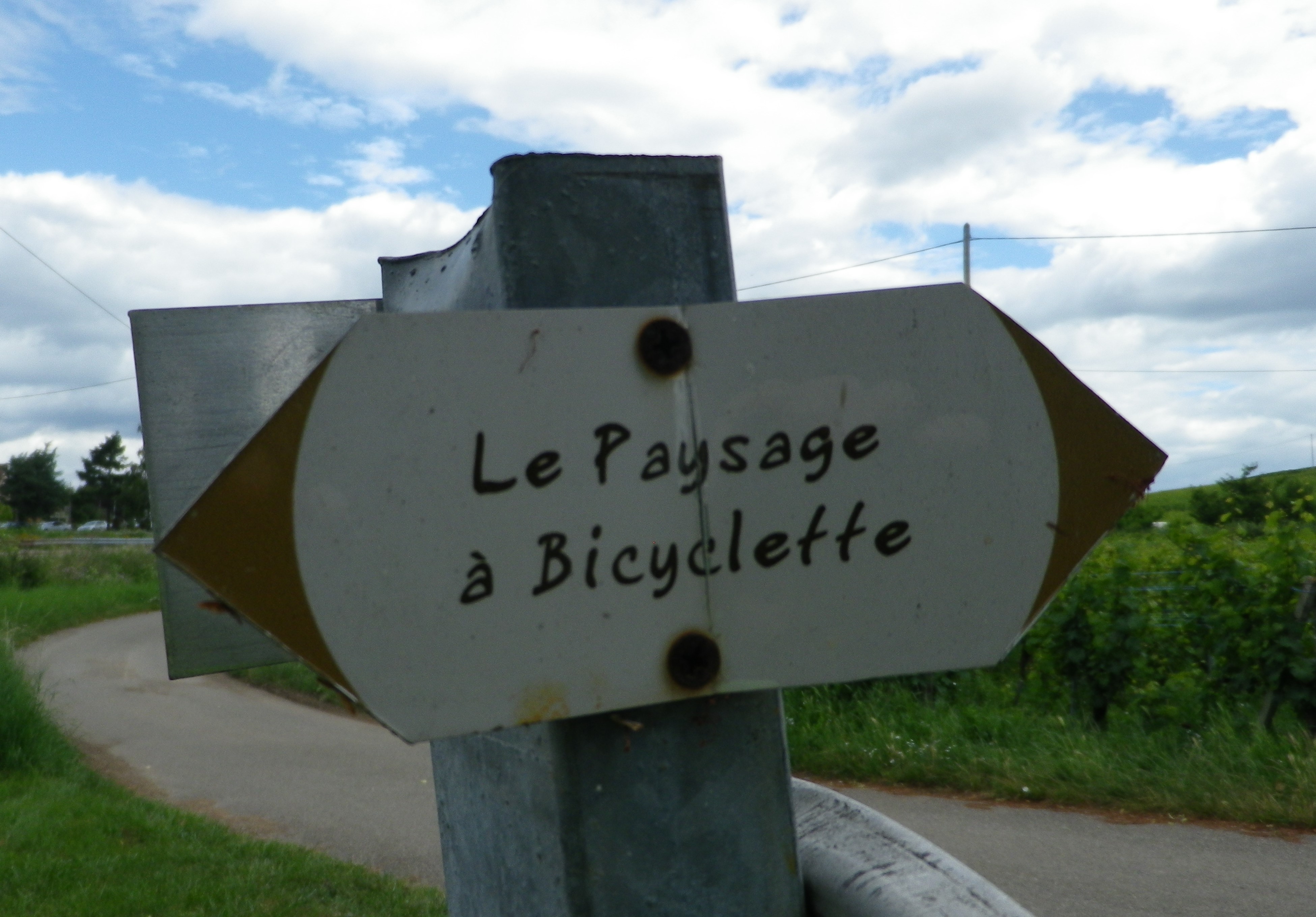
Trail Description: A slightly challenging trail through vines and villages in a relatively quiet section of the Alsatian wine region, offering plenty of opportunities to reconnect with nature, admire the wide expanses, and taste wine while exploring small towns and villages along the route!
Trailhead:
Official: Rouffach: Mairie (Town Hall), on Place de la Republique
Alternative: Eguisheim: Grande Rue
Parking:
Eguisheim: Grande Rue, large paved lot, reasonable fees
Rouffach: Place des Sports, large paved lot, with overflow parking nearby, free
Public Transportation Options:
Rail: SNCF regional trains (TER), regularly connect Rouffach (station less than one kilometer from the trail) with Colmar and Strasbourg to the north, and Mulhouse to the south
Suggested Stages:
Not applicable
Trail Itinerary-Reference Points:
Rouffach: R du Marechal Joffre/D18Bis-R Claude Ignace Callinet, R. Louis Pasteur-R. des Vosges-Route de Westhalten; Cross Muehlweg, onto track named Saegmattenweg; Gundolsheim: D15/Route de Rouffach-R. du Nord-Schlittweg-Gundolsheimerweg; onto Holderhuerstleweg, over train tracks, hard right but continue on trail, Rouffach: cross D8, Heiligkreuzweg-Staaweg; cross tracks, then parallel them on Gaertleweg; Metzgermatten and Kiffmatten fields; woods, cross D83 highway; Hattstatt: D121/Route du Vin; Alte Staatstrasse, Herrenstr trail, Rte de Herrlisheim/D1bis; Eguisheim: D14/Grande Rue, R. du Muscat-R du Vin, unnamed trail to left after R. du Buhl; Obermorschwihr: Dagsbourg Hohlweg, R du Dagsbourg-R des Pres; fields and vineyards; Gueberschwihr: R du Nord, R Basse-Route de Pfaffenheim; Gaensbrunnweg trail, then first right; Pfaffenheim: R du Muscat, Grande Rue-Drotfeldweg-Kopfacherweg; Alte Strasse through vineyards-R. Louis Pasteur
Representative Trail Photos:
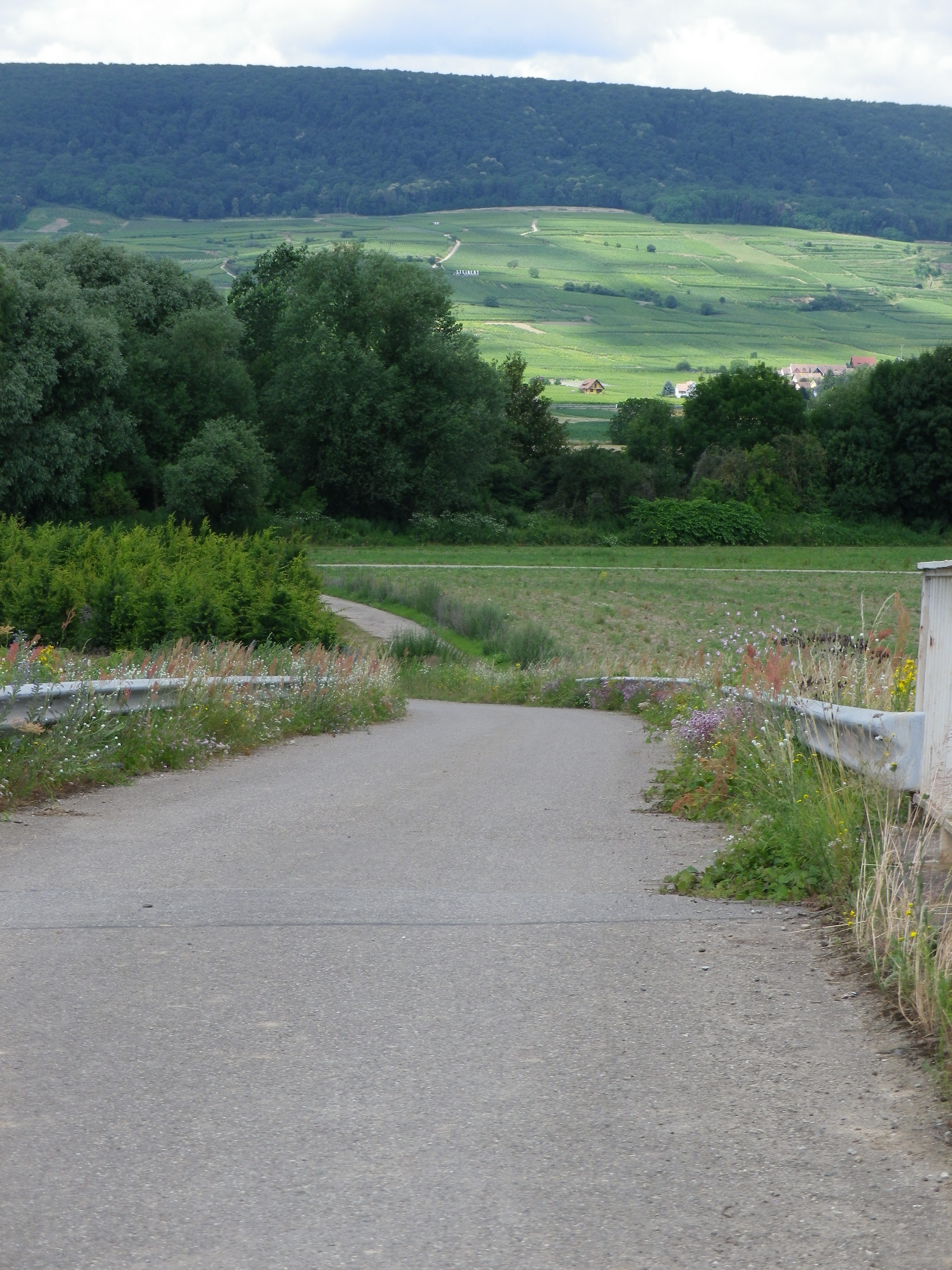
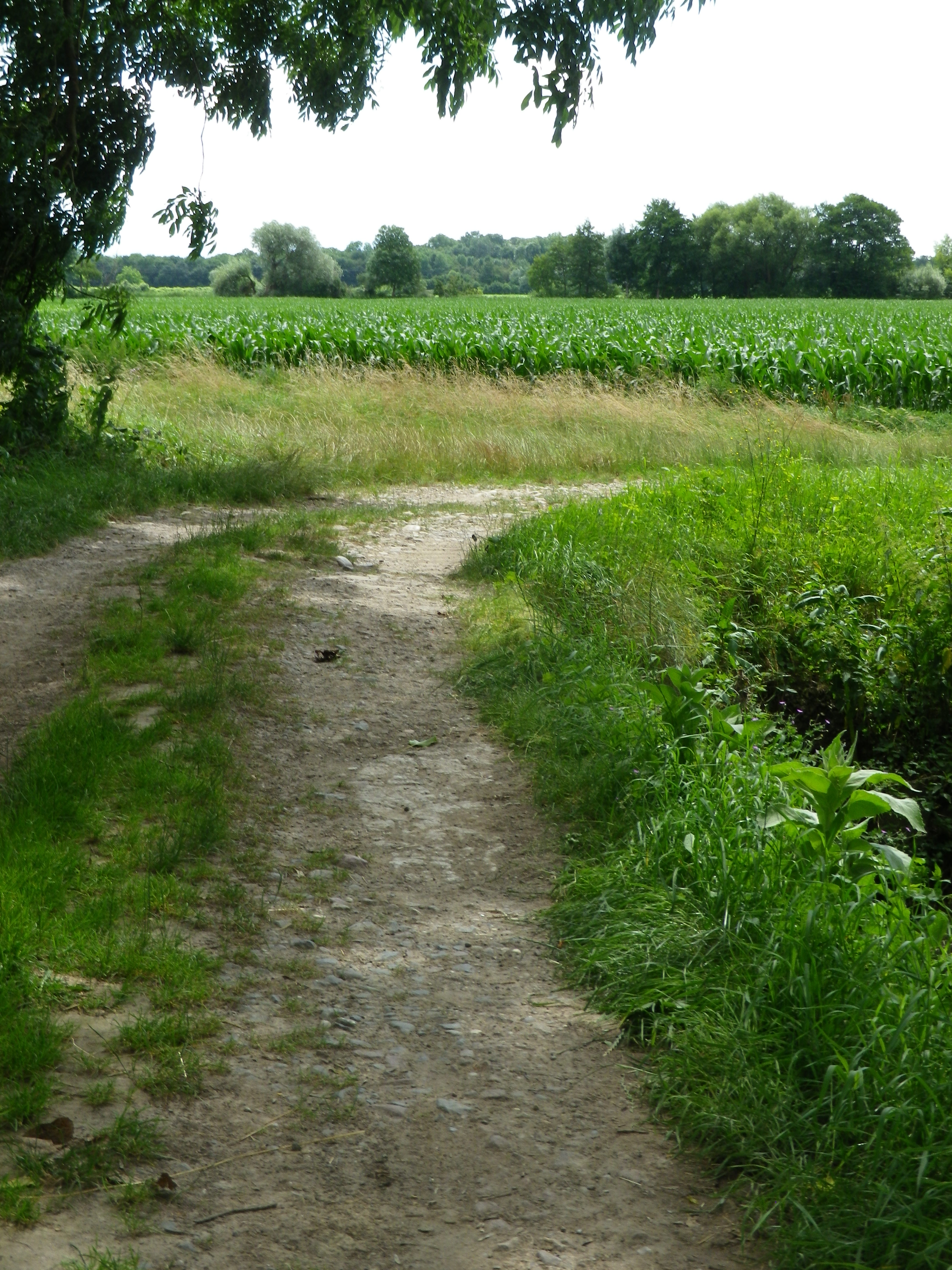
Restrooms:
Rouffach: R. du 4eme Spahis Marocains (by the bus stop)
Eguisheim: by the paid parking lot (see parking above), and in the old center in Cr Unterlinden
Attractions on or near Trail:
Eguisheim:
The Little Train will take passengers through vineyards as well as the town
The Wolfberger Cave has a discovery room with some explanations and photos, in addition to a large boutique for lots of its wine and wine-related products.
Tasting along the Trail:
Wineries, mostly family-owned, in every village – you will be spoiled for choice. Do not hesitate to visit one (or several) between roughly 9-1200, and 14-1800 on most days (some including Sunday mornings during tourism season)!
Alternative Options:
Hiking:
Eguisheim: Vignoble et Chateaux, a short but steep in places trail that passes through a great variety of scenery and terrain, with great views. See the Nutshell here.
Soultzmatt or Westhalten: https://www.visorando.com/randonnee-promenade-dans-le-vignoble-de-la-vallee-/ thru vineyards, listed as medium difficulty (hills, not much shade)
Additional Information:
Trail (segment) specific: https://www.cirkwi.com/fr/circuit/536654-le-paysage-a-bicyclette
Comments:
A fantastic area for wines, history, and hiking and biking in nature.
